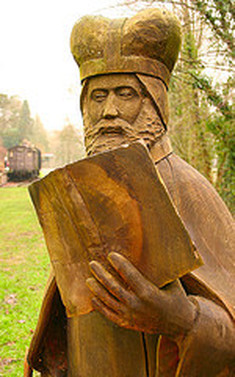I don’t really have any excuses – I’ve simply been giving priority to my own little pleasures. Therefore, I think I should set aside at least one day a week for the blog. I can’t promise anything, but I can try. Given today, I’ll shoot for Saturday.
To business! I believe you can’t have a proper discussion of fantasy in Western culture without bringing up at some point the Matter of Britain, of which King Arthur and the Knights of the Round Table are of chief importance. The last post, among other things, touched upon a few central figures who have been influential in shaping the conception of Camelot, both ancient and modern; today, I’m going to draw attention to five more figures just as essential to the development of the Matter and deserving of further inquiry for modern fantasy fans.
GEOFFREY OF MONMOUTH (c. 1100 – c. 1155)
Arguably the entire Matter began here with this (allegedly) Welsh cleric, who is also a central figure in the development of British historiography. The work in question is Historia Regum Britanniae, or, in colloquial English, History of the Kings of Britain, a chronicle of British history from its founding by a descendent of Aeneas of Troy to the 7th century. Granted, most scholars accept it as more fiction than fact, embellished with extraordinary flourish, but there seems to be little doubt that it laid most of the foundations from which the chief concepts of Arthur and Merlin have been developed, providing inspiration for later writers like de Troyes and Malory.
Offsite resources:
Bartleby.com – Excerpt from Latin Chroniclers from the Eleventh to the Thirteenth Centuries
The Camelot Project – Introduction by Emily Rebekah Huber
WOLFRAM VON ESCHENBACH (c. 1160/80 – c.1220)
The Matter is also expanded upon by German poets, and Wolfram von Eschenbach is regarded as one of the greatest, though little is known about the man himself. His contribution to Arthurian lore is to finish what de Troyes could not with the epic Parsival, following the life of the titular character from birth to ignorant youth to keeper of the Holy Grail; arguably considered the greatest medieval German epic poem, and having introduced the Grail story into German literature, it is an original story in itself, not wholly dependant on de Troyes’s unfinished work, and meditative on themes of sympathy, compassion, love and spirituality. In modern times, it would achieve further immortalization through Richard Wagner’s opera of the same name. Von Eschenbach is also the author of two other works, Willehalm and Titurel, both unfinished.
Offsite resources:
Monsalvat – The Parsival Home Page
Background and Summary of Parsival
HARTMANN VON AUE (c. 1160/70 – c. 1210/20)
Following a similar path as von Eschenbach, Hartmann von Aue also adapted work by de Troyes and made it his own – in this case, Erec, in which the German Arthurian legend is introduced, and Iwein, a courtly romance. Other works of importance are Gregorius, which follows an il-born child into the papacy, and Der arme Heinrich, in which a knight afflicted with leprosy can only be cured by a willing virginal sacrifice. Von Aue’s style is considered more inclined to impart morality than any great stylistic elegance, compared to other writers, but this has not prevented him from being considered one of the three great epic poets of medieval German literature.
Offsite resources:
GOTTFRIED VON STRASSBURG (? – c. 1210)
The third and final great German epic poet, of whom little is known beyond his name, Gottfried von Strassburg’s major work is the unfinished Tristan, a German retelling of the famous Tristan and Iseult legend carefully constructed with symmetrical workmanship and ironic narrative; it is ranked alongside Parsival and the legendary Nibelungenlied as one of the greatest German masterpieces. His vision seems to be derived more from Christian mysticism than the traditional knightliness of his contemporaries.
Offsite resources:
SIR THOMAS MALORY (c. 1415/18 – 1471)
Except for T. H. White, perhaps no other writer’s version of Arthur has been more influential or well-received as that of Sir Thomas Malory and his Le Morte d’Arthur, which compiles most of the previously known tales regarding the story of Camelot into a single work. Malory himself is believed to be from Newbold Revel in Warwickshire, having served as a knight himself and a member of Parliament as well as being accused of numerous ill deeds. The Morte itself is has been called an idealistic parallel to his own time, the rise and fall of Arthur’s court serving to give warning to the higher powers of the dangers of infighting. It has served to cement most of what has become common knowledge of the Matter of Arthur, serving as inspiration for both White himself as well as Tennyson’s poem cycle Idylls of the King.
Offsite resources:
Luminarium: Anthology of English Literature
That’s all for now. Next time will be further entries previously found on the forum topic, which can be found here, as always: http://www.lostpathway.com/tavern/index.php/topic,16.0.html




0 comments